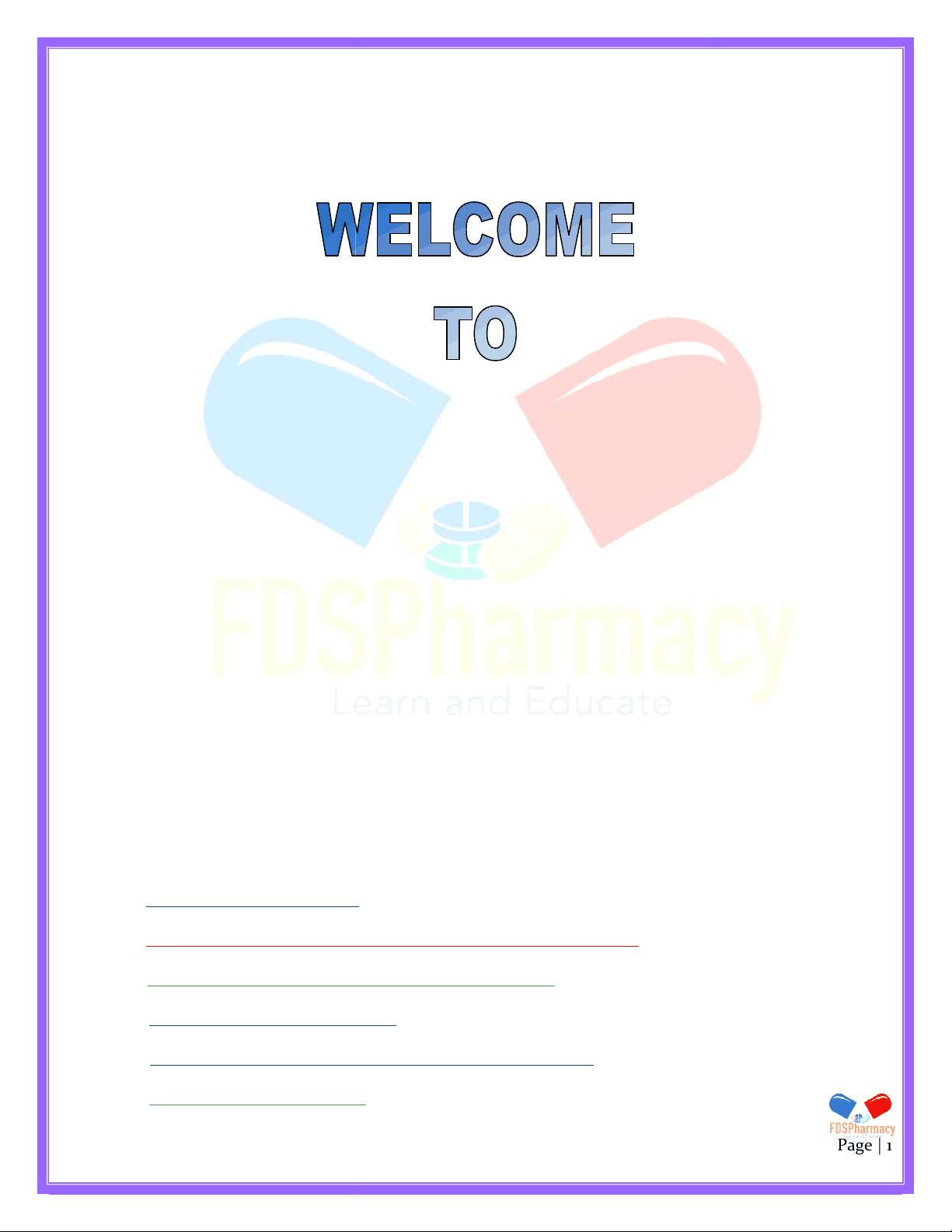
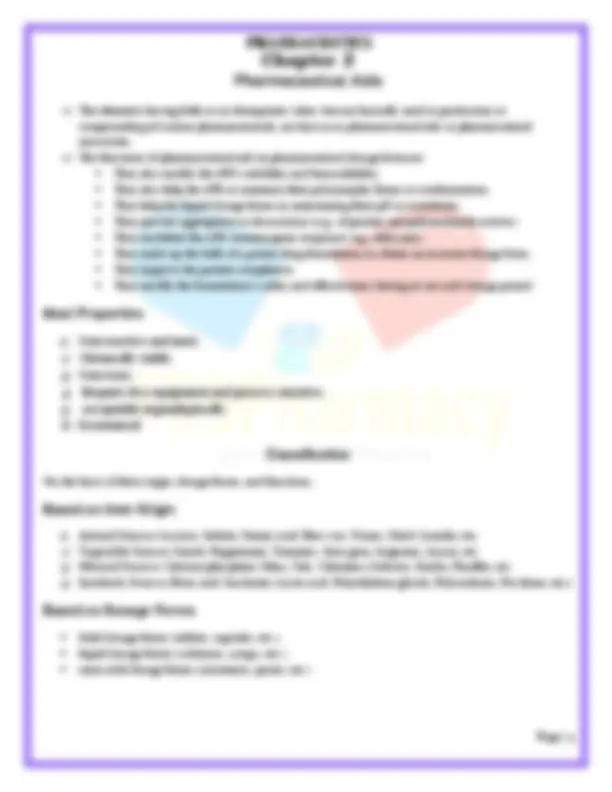
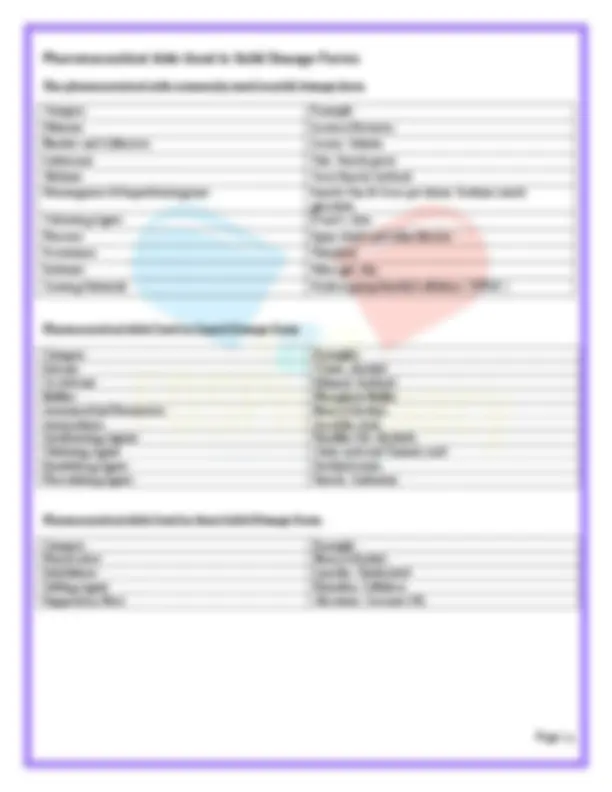
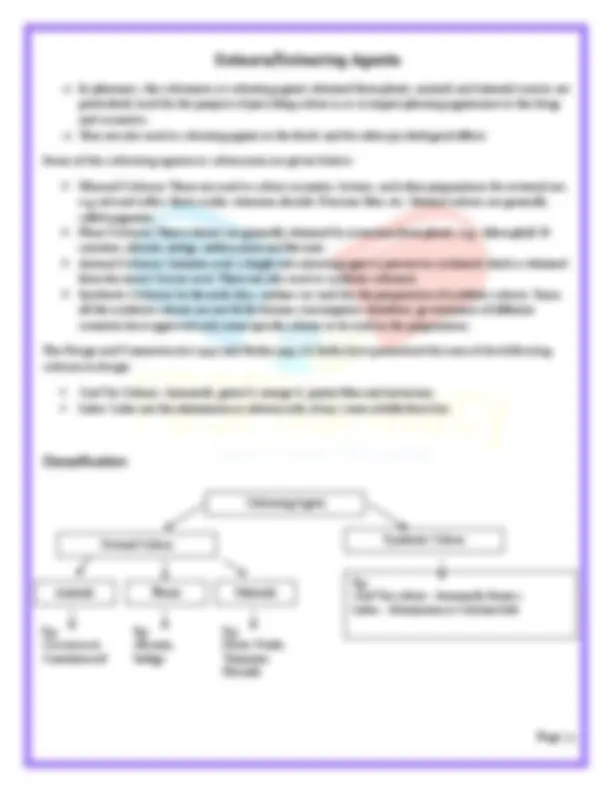
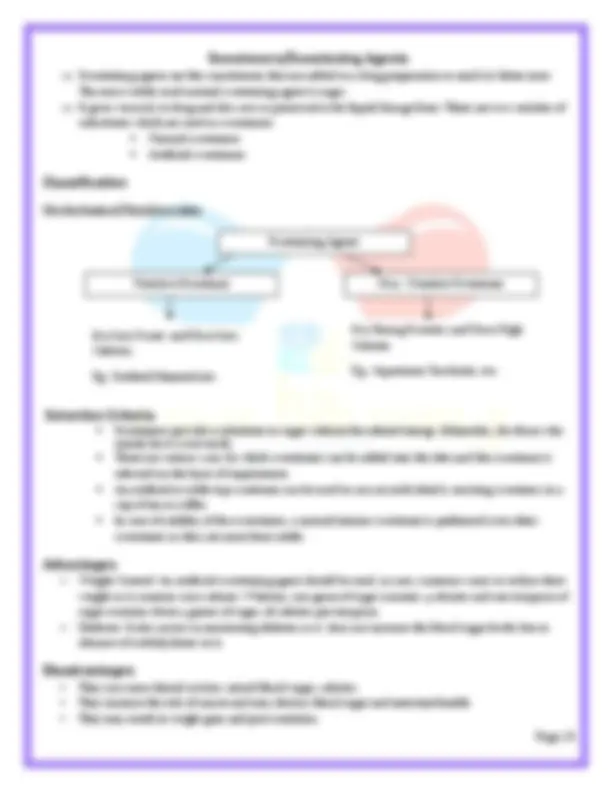
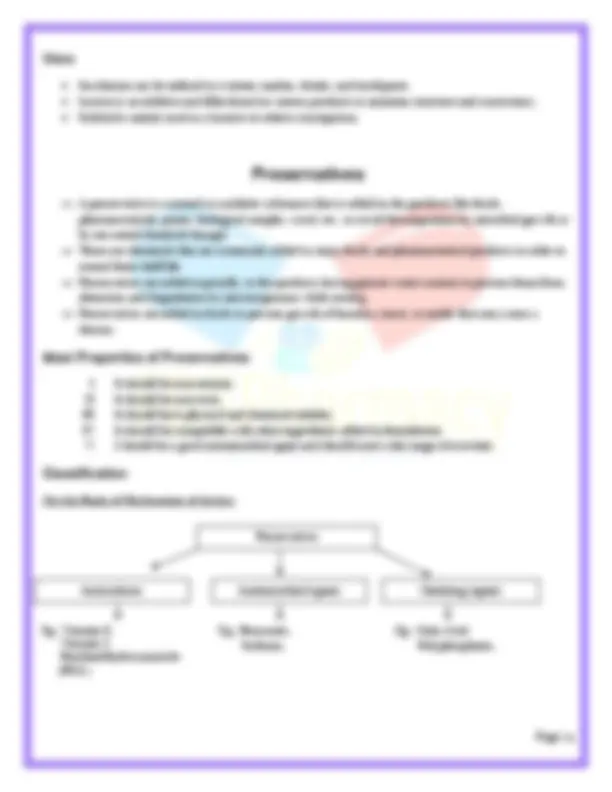
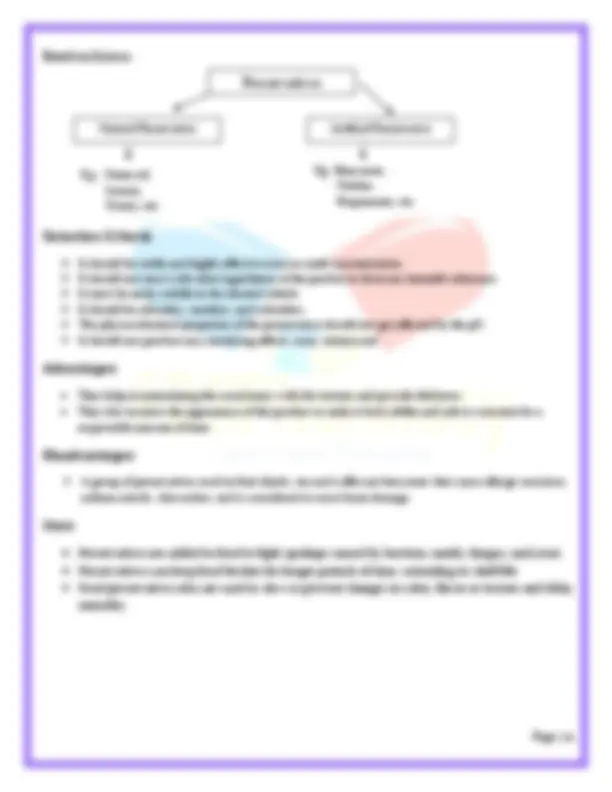


Study with the several resources on Docsity

Earn points by helping other students or get them with a premium plan


Prepare for your exams
Study with the several resources on Docsity

Earn points to download
Earn points by helping other students or get them with a premium plan
Community
Ask the community for help and clear up your study doubts
Discover the best universities in your country according to Docsity users
Free resources
Download our free guides on studying techniques, anxiety management strategies, and thesis advice from Docsity tutors
Hii sir good morning how are things going
Typology: Cheat Sheet
1 / 11

This page cannot be seen from the preview
Don't miss anything!







Web Site http://www.fdspharmacy.in/ You tube https://www.youtube.com/channel/UC77iEsiuZ0lU4pB8WAJIR5Q What app https://chat.whatsapp.com/IzSgXtFEvhS4LN5xhUgq5z Telegram https://t.me/+cvxm17xSloA4MjVl Face book https://www.facebook.com/Fdspharmacy E-mail fdspharmacyinfo@gmail.com
http://www.fdspharmacy.in/ https://www.youtube.com/channel/UC77iEsiuZ0lU4pB8WAJIR5Q https://chat.whatsapp.com/IzSgXtFEvhS4LN5xhUgq5z https://t.me/+cvxm17xSloA4MjVl https://www.facebook.com/Fdspharmacy-105764311994440/ fdspharmacyinfo@gmail.com
Pharmaceutical Aids Colours/Colouring Agents Flavouring agents Sweeteners/Sweetening Agents Preservatives
Sweeteners/Sweetening Agents
3 5 6 8 9
Pharnmaceutical Aids Used in Solid Dosage Forms The pharmaceutical aids commonly used in solid dosage form Category Example Diluents Lactose,Dextrose, Binders and Adhesives Acacia, Gelatin Lubricants Talc, Starch paste Glidants Corn Starch,Carbosil, Disintegrants & Superdisintegrants Starch,Clay,& Cross povidone, Sodium starch glycolate Colouring Agent D and c dyes Flavours Spray dried and other flavour Sweeteners Mannitol, Sorbents Silica gel, clay, Coating Materials Hydroxypropylmethyl cellulose ( HPMC ) Pharmaceutical Aids Used in Liquid Dosage Form Category Examples Solvent Water, Alcohol Co-Solvent Ethanol, Sorbitol Buffers Phosphate Buffer, Antimicrobial Preserative Benzyl Alcohol, Antioxidants Ascorbic Acid Antifoaming Agents Paraffin Oil, Alcohols, Chelating Agent Citric acid and Tartaric acid Emulsifyng Agent Sorbitol esters, Flocculating Agent Starch, Carbomer Pharmaceutical Aids Used in Semi-Solid Dosage Form Category Example Preservative Benzyl Alcohol, Solubilisers Lanolin, Cholesterol Gelling Agent Pemulen, Cellulose Suppository Base Glycerine, Coconut Oil,
In pharmacy, the colourants or colouring agents obtained from plants, animals and mineral sources are particularly used for the purpose of providing colour so as to impart pleasing appearance to the drugs and cosmetics. They are also used as colouring agents in the foods and for other psychological effects. Some of the colouring agents or colourants are given below: Mineral Colours: These are used to colour cosmetics, lotions, and other preparations for external use, e.g, red and yellow ferric oxides, titanium dioxide, Prussian blue, etc. Mineral colours are generally called pigments. Plant Colours: These colours are generally obtained by extraction from plants, e.g., chlorophyll, B- carotene, alizarin, indigo, anthocyanin and flavones. Animal Colours: Carminic acid, a bright red colouring agent is present in cochineal which is obtained from the insect Coccus cacti. These are also used as synthetic colorants. Synthetic Colours: In the early days, aniline was used for the preparation of synthetic colours. Since, all the synthetic colours are not fit for human consumption; therefore, governments of different countries have approved only some specific colours to be used in the preparations. The Drugs and Cosmetics Act 1940 and Rules 1945, in India have permitted the use of the following colours in drugs: Coal Tar Colours: Amaranth, green S, orange G, patent blue and tartrazine. Lakes: Lakes are the aluminium or calcium salts of any water soluble food dye. Classification Colouring Agent Natural Colour Synthetic Colour Animals Plants Minerals Eg : Coccuscacti: Carminicacid Eg : Alizarin, Indigo Eg : Ferric Oxide, Titanium Dioxide Eg : Coal Tar colour : Amaranth,Green s Lakes : Aluminium or Calcium Salt
Classsification Selection Criteria The qualities of the taste of flavour. Suitability of the combination of flavour, colour and sweetener. Type of the preparation, whether for internal or external use. Patient's age. General liking and disliking of the intended users. Best flavour for a particular product is usually selected by forming a panel and by the consent of majority. Advantages I. The unpleasant taste of the medicament is masked by the flavouring agents. II. These agents help in increasing patient compliance for tablets that are chewable. Disadvantages There are certain intolerable flavours that cannot be masked, e.g., in case of male fern extract, which is initially sweet, then astringent and finally bitter in taste. The formulations meant for patients on reducing diets or diabetics do not contain the sweetening agents that increase calories or blood sugar levels. Uses Flavouring agents aids in masking the disagreeable odour or taste of the medications so as to increase the patient's acceptance towards the drug. They induce an acceptable flavour in the medicament. Flavours/Flavouring Agents Sweetening Agent Flavoures Syrup Aromatic Oils Synthesis Flavours Eg : Surcose, Saccharin, Eg : Fruit syrup Vegetables Syrup Cocoa Syrup Eg : Volatile Oil, Lemon, Peppermint, Orange, Ginger Eg : Vanilla, Benzaldehyde.
Sweeteners/Sweetening Agents Sweetening agents are the constituents that are added to a drug preparation to mask its bitter taste. The most widely used natural sweetening agent is sugar. It gives viscosity to drug and also acts as preservative for liquid dosage form. There are two varieties of substitutes which are used as sweeteners: Natural sweeteners Artificial sweeteners Classification On the basis of Nutritive value Selection Criteria Sweeteners provide a substitute to sugar without the related energy (kilojoules), for those who mainly have sweet tooth. There are various ways by which sweeteners can be added into the diet and the sweetener is selected on the basis of requirement. An artificial or table top sweetener can be used in case an individual is resisting sweetness in a cup of tea or coffee. In case of stability of the sweeteners, a natural intense sweetener is prefeerred over other sweeteners as they are more heat stable. Advantages Weight Control: An artificial sweetening agent should be used, in case; someone wants to reduce their weight as it contains zero calories. Whereas, one gram of sugar contains 4 calories and one teaspoon of sugar contains about 4 grams of sugar, 16 calories per teaspoon. Diabetes: It also assists in monitoring diabetes as it does not increase the blood sugar levels due to absence of carbohydrates in it. Disadvantages They can cause dental cavities, raised blood sugar, calories. They increase the risk of cancer and may destroy blood sugar and intestinal health. They may result in weight gain and poor nutrition. Sweetening Agents Nutritive Sweetener Non - Nutritive Sweetener It is Less Sweet and Have Less Calories. Eg : Sorbitol,Mannitol,etc. It is Strong Sweeter ,and Have High Calories Eg : Aspartame, Saccharin, etc.
Based on Source: Selection Criteria It should be stable and highly effective even in small concentrations. It should not react with other ingredients of the product to form any harmful substance. It must be easily soluble in the desired vehicle. It should be odourless, tasteless, and colourless. The physicochemical properties of the preservative should not get affected by the pH. It should not produce any sensitising effects. toxic, irritant and Advantages They help in maintaining the consistency with the texture and provide thickness. They also increase the appearance of the product to make it look edible and safe to consume for a respectable amount of time. Disadvantages A group of preservatives used in fruit drinks, tea and coffee are benzoates that cause allergic reactions, asthma attacks, skin rashes, and is considered to cause brain damage. Uses
Preservatives Natural Preservative Artifical Preservative Eg : Neem oil, Lemon, Honey, etc. Eg : Benzoates, Nitrites, Propionates, etc.